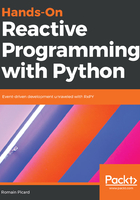
Event-driven programming
What is the common connection between state machines, Petri net, Kahn Process Networks (KPN), the observer design pattern, callbacks, pipes, publish/subscribe, futures, promises and streams? Event-driven programming!
By definition, any program has to deal with external events through inputs/outputs (I/O). I/O and event management are the foundations of any computer system: reading or writing from storage, handling touch events, drawing on a screen, sending or receiving information on a network link, and so on. Nothing useful can be done without interacting with I/O, and I/O are almost always managed through events. However, 50 years after the creation of the first microprocessor, event-driven programming is still a very active topic with new technologies appearing almost every year.
The main purpose of this important activity is that, despite the fact that event-driven programming has existed since the beginning of computer science, it is still hard to use correctly. More than writing event-driven code, the real challenge lies in writing readable, maintainable, reusable, and testable code. Event-driven programming is more difficult to implement and read than sequential programming because it often means writing code that is not natural to read for human beings—instead of a sequence of actions that execute one after the other until the task to execute is completed, the beginning of an action starts when an event occurs, and then the actions that are triggered are often dispersed within the program. When such a code flow becomes complex—and this starts only after few indirect paths in a code—then it becomes more and more difficult to understand what is happening. This is what is often called the callback hell. One has to follow callbacks calling callbacks, which call further callbacks, and so on.
During the late nineties, event-driven programming became quite popular with the advent of graphical user interfaces (GUIs). At that time, developers had the following options to write GUI applications:
- Objective-C on NextStep and macOS
- C++ on Windows
- C or eventually C++ on Unix (with X11)
- Java, with the hope of writing the same application for all these systems
All these environments were based on callbacks and it stayed that way for a very long time, until programming languages included features to improve the readability of event-driven code.
So event-driven code is often more difficult to read than sequential code because the code logic can be difficult to follow, depending on the programming language and the frameworks being used. Reactive programming, and more specifically ReactiveX, aims at solving some of these challenges. Python and its relatively recent support of async/await syntax also aims to make event-driven programming easier.
It is important to understand that reactive programming and event-driven programming are not programming paradigms, such as imperative or object-oriented programming, but are orthogonal to them. Event-driven programming is implemented within an existing paradigm. So, one can use event-driven programming with an object-oriented language or a functional language. Reactive programming is a specific case of event-driven programming. This can be seen in the following figure:
